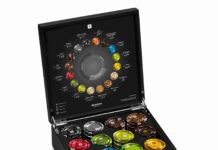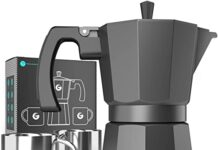If you love your morning cup of joe as much as we do, then you’ve probably heard of Bialetti pots. These Italian-made coffee makers have gained a cult following for their iconic design and ability to brew a perfect cup of espresso. But when it comes to choosing between aluminum and stainless steel Bialetti pots, the decision can be a bit overwhelming. In this article, we’ll break down the key differences between the two materials so that you can make an informed choice for your next brew.
Construction Material
When it comes to Bialetti pots, there are two main construction materials to choose from: aluminum and stainless steel. Each material has its own unique characteristics and benefits. Let’s delve into the differences between these two options and help you make an informed decision.
Aluminum
Aluminum Bialetti pots are a popular choice among many home cooks and professional chefs alike. One of the main advantages of aluminum pots is their excellent heat conductivity. Aluminum is known for its ability to distribute heat quickly and evenly, which results in efficient cooking. This means that your food will be cooked more evenly, reducing the chances of over- or under-cooking.
Another benefit of aluminum pots is their lightweight nature. Aluminum is a lightweight metal, making it easy to handle and maneuver in the kitchen. This is particularly advantageous for those who have difficulty lifting heavy objects or want pots that are easy to transport.
Stainless Steel
On the other hand, stainless steel Bialetti pots are known for their durability and longevity. Stainless steel is a heavier and sturdier material compared to aluminum, which provides a sense of robustness in the kitchen. These pots are built to withstand the test of time and can handle heavy use without losing their shape or structural integrity.
Stainless steel pots also offer superior resistance to corrosion and rust, making them ideal for long-term use and easy maintenance. They are less prone to staining, even when exposed to acidic ingredients, and are generally more resistant to wear and tear. This makes stainless steel pots a great investment for those who prioritize longevity and durability in their cookware.
Heat Conductivity
When it comes to heat conductivity, aluminum pots have a significant advantage over stainless steel pots. Aluminum is an excellent conductor of heat, which means that it quickly and efficiently transfers heat from the heat source to the food inside the pot. This ensures faster cooking times and even heat distribution throughout the entire pot, resulting in evenly cooked meals.
In contrast, stainless steel is not as effective at conducting heat as aluminum. Stainless steel pots can develop hot spots, where certain areas of the pot heat up more than others. This can lead to uneven cooking and potentially burned or undercooked food. However, it’s worth noting that some stainless steel pots may have a layer of aluminum or copper added to their base to enhance heat conductivity.
Durability
When it comes to durability, stainless steel pots shine. Stainless steel is incredibly durable, resistant to scratches, dents, and pitting, making it an excellent long-term investment for your kitchen. These pots can withstand heavy use, high temperatures, and vigorous cleaning without losing their shape or integrity. Stainless steel pots are designed to last a lifetime, making them an excellent choice for those who want reliable and sturdy cookware.
Aluminum pots, although not as durable as their stainless steel counterparts, are still quite resilient. They are less likely to dent or scratch compared to other materials, but they may be more prone to warping if exposed to sudden temperature changes. If well taken care of, aluminum pots can also last for a significant amount of time.
Weight
Weight is an important factor to consider when choosing between aluminum and stainless steel Bialetti pots. Aluminum pots are considerably lighter than stainless steel pots, which makes them easier to handle, especially when transferring food from stove to table. This can be a significant advantage for individuals who prefer lightweight cookware or have limitations in their physical strength.
Stainless steel pots, on the other hand, are heavier due to their solid construction and thicker walls. The added weight provides a sense of durability and stability, but it might be less practical for those who have difficulty lifting heavy objects or prefer more lightweight kitchenware.
Maintenance
Maintaining your Bialetti pots plays a crucial role in their longevity and performance. In terms of maintenance, stainless steel pots are generally easier to care for than aluminum pots. Stainless steel is non-reactive and resists the formation of stains and odors, making it less demanding to clean. These pots can usually be safely washed in a dishwasher without the risk of damage, although hand-washing is always preferred for optimal care.
On the other hand, aluminum pots require a bit more attention and care. Aluminum is a softer metal and more prone to scratching and discoloration. It is advisable to hand-wash aluminum pots and avoid using abrasive cleaning tools or harsh chemicals that could damage the surface. Regular maintenance and proper cleaning methods are essential to keep your aluminum pots in top condition.
Corrosion Resistance
When it comes to corrosion resistance, stainless steel pots have the upper hand. Stainless steel is highly resistant to corrosion and rust, even when exposed to acidic ingredients or cooking methods. This makes stainless steel pots an excellent choice for cooking a wide range of foods, including those that are highly acidic or require prolonged cooking times.
Aluminum, while not inherently prone to rusting, can react with certain acidic foods and develop a metallic taste. To prevent this, many aluminum pots are coated with a non-reactive layer, such as anodized aluminum or non-stick coatings. However, it’s important to note that these coatings may wear off over time and need to be replaced or repaired.
Cooking Performance
In terms of cooking performance, both aluminum and stainless steel pots have their strengths. Aluminum pots excel in heat conductivity, allowing for quick and even heat distribution. This makes them ideal for tasks such as boiling water, simmering soups, and cooking sauces that require precise temperature control.
Stainless steel pots, although not as efficient in heat conductivity, offer other advantages in cooking performance. They retain heat well, which is particularly beneficial for recipes that require longer cooking times, such as slow cooking or braising. The heavier build of stainless steel pots also allows for better heat retention, reducing the chances of temperature fluctuations during the cooking process.
Price
Price is often a determining factor when choosing between aluminum and stainless steel Bialetti pots. Aluminum pots tend to be more budget-friendly compared to stainless steel pots. The cost of aluminum pots is generally lower due to the lower cost of materials and easier manufacturing process. This makes aluminum pots a popular choice for those on a tighter budget or beginners looking to invest in their first set of cookware.
On the other hand, stainless steel pots are a bit more expensive due to the higher cost of materials and the durability they offer. However, stainless steel pots are considered a long-term investment, as they are built to last and offer superior durability over time. If you consider the longevity and performance of stainless steel pots, the higher price can be justified.
Aesthetics
The choice between aluminum and stainless steel pots also comes down to personal preferences in terms of aesthetics. Aluminum pots often have a sleek and polished appearance, giving them a modern and sophisticated look. They are available in various colors and finishes, making it easier to match them with your kitchen decor or personal style.
On the other hand, stainless steel pots have a classic and timeless appeal. The shiny and reflective surface of stainless steel gives them a professional and elegant appearance, making them a popular choice for many professional kitchens. Stainless steel pots provide a clean and polished look that can elevate the overall aesthetic of your kitchen.
Safety Measures
Safety should always be a top priority when choosing cookware. Both aluminum and stainless steel Bialetti pots are considered safe for cooking purposes. However, there are a few safety measures to be aware of.
Aluminum pots, if uncoated or not lined with a non-reactive layer, can react with certain acidic foods and release small amounts of aluminum into the food. While this is generally considered safe in normal cooking conditions, individuals with aluminum sensitivities or certain health concerns may prefer to opt for coated aluminum pots or stainless steel pots instead.
Stainless steel pots, when cared for properly, do not leach any harmful substances into food. It is essential to verify that the stainless steel used in the pots is of high quality and free from any coatings or materials that may release harmful chemicals. Choosing reputable brands like Bialetti ensures that the pots are made from food-grade stainless steel and meet safety standards.
In conclusion, the choice between aluminum and stainless steel Bialetti pots ultimately comes down to personal preferences, cooking needs, and budget considerations. Aluminum pots offer excellent heat conductivity, lightweight design, and budget-friendly prices. Stainless steel pots, on the other hand, provide durability, longevity, and superior corrosion resistance. Consider the specific advantages and characteristics of each material to make an informed decision that suits your cooking style and kitchen requirements.































